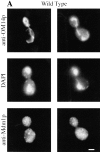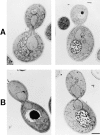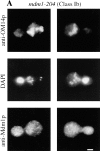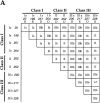Mutational analysis of Mdm1p function in nuclear and mitochondrial inheritance
- PMID: 9245780
- PMCID: PMC2141631
- DOI: 10.1083/jcb.138.3.485
Mutational analysis of Mdm1p function in nuclear and mitochondrial inheritance
Abstract
Nuclear and mitochondrial transmission to daughter buds of Saccharomyces cerevisiae depends on Mdm1p, an intermediate filament-like protein localized to numerous punctate structures distributed throughout the yeast cell cytoplasm. These structures disappear and organelle inheritance is disrupted when mdm1 mutant cells are incubated at the restrictive temperature. To characterize further the function of Mdm1p, new mutant mdm1 alleles that confer temperature-sensitive growth and defects in organelle inheritance but produce stable Mdm1p structures were isolated. Microscopic analysis of the new mdm1 mutants revealed three phenotypic classes: Class I mutants showed defects in both mitochondrial and nuclear transmission; Class II alleles displayed defective mitochondrial inheritance but had no effect on nuclear movement; and Class III mutants showed aberrant nuclear inheritance but normal mitochondrial distribution. Class I and II mutants also exhibited altered mitochondrial morphology, possessing primarily small, round mitochondria instead of the extended tubular structures found in wild-type cells. Mutant mdm1 alleles affecting nuclear transmission were of two types: Class Ia and IIIa mutants were deficient for nuclear movement into daughter buds, while Class Ib and IIIb mutants displayed a complete transfer of all nuclear DNA into buds. The mutations defining all three allelic classes mapped to two distinct domains within the Mdm1p protein. Genetic crosses of yeast strains containing different mdm1 alleles revealed complex genetic interactions including intragenic suppression, synthetic phenotypes, and intragenic complementation. These results support a model of Mdm1p function in which a network comprised of multimeric assemblies of the protein mediates two distinct cellular processes.
Figures













Similar articles
-
Nuclear and mitochondrial inheritance in yeast depends on novel cytoplasmic structures defined by the MDM1 protein.J Cell Biol. 1992 Jul;118(2):385-95. doi: 10.1083/jcb.118.2.385. J Cell Biol. 1992. PMID: 1378448 Free PMC article.
-
A role for ubiquitination in mitochondrial inheritance in Saccharomyces cerevisiae.J Cell Biol. 1999 Jun 14;145(6):1199-208. doi: 10.1083/jcb.145.6.1199. J Cell Biol. 1999. PMID: 10366593 Free PMC article.
-
Intermediate filament formation by a yeast protein essential for organelle inheritance.Science. 1993 Apr 30;260(5108):687-9. doi: 10.1126/science.8480179. Science. 1993. PMID: 8480179
-
Temperature-sensitive yeast mutants defective in mitochondrial inheritance.J Cell Biol. 1990 Sep;111(3):967-76. doi: 10.1083/jcb.111.3.967. J Cell Biol. 1990. PMID: 2202739 Free PMC article.
-
The yeast gene, MDM20, is necessary for mitochondrial inheritance and organization of the actin cytoskeleton.J Cell Biol. 1997 Apr 7;137(1):141-53. doi: 10.1083/jcb.137.1.141. J Cell Biol. 1997. PMID: 9105043 Free PMC article.
Cited by
-
Desmin cytoskeleton linked to muscle mitochondrial distribution and respiratory function.J Cell Biol. 2000 Sep 18;150(6):1283-98. doi: 10.1083/jcb.150.6.1283. J Cell Biol. 2000. PMID: 10995435 Free PMC article.
-
A heritable structural alteration of the yeast mitochondrion.Genetics. 2002 Aug;161(4):1425-35. doi: 10.1093/genetics/161.4.1425. Genetics. 2002. PMID: 12196390 Free PMC article.
-
The Phox homology (PX) domain, a new player in phosphoinositide signalling.Biochem J. 2001 Dec 15;360(Pt 3):513-30. doi: 10.1042/0264-6021:3600513. Biochem J. 2001. PMID: 11736640 Free PMC article. Review.
-
Host-induced gene silencing of a regulator of G protein signalling gene (VdRGS1) confers resistance to Verticillium wilt in cotton.Plant Biotechnol J. 2018 Feb 12;16(9):1629-43. doi: 10.1111/pbi.12900. Online ahead of print. Plant Biotechnol J. 2018. PMID: 29431919 Free PMC article.
-
Structural basis for different phosphoinositide specificities of the PX domains of sorting nexins regulating G-protein signaling.J Biol Chem. 2014 Oct 10;289(41):28554-68. doi: 10.1074/jbc.M114.595959. Epub 2014 Aug 22. J Biol Chem. 2014. PMID: 25148684 Free PMC article.
References
-
- Adams RJ, Pollard TD. Propulsion of organelles isolated from Acanthamoeba along actin filaments by myosin-I. Nature (Lond) 1986;322:754–756. - PubMed
-
- Allan V. Membrane traffic motors. FEBS (Fed Eur Biochem Soc) Lett. 1995;369:101–106. - PubMed
-
- Berger KH, Yaffe MP. Mitochondrial distribution and inheritance. Experientia (Basel) 1996;52:1111–1116. - PubMed
-
- Chen LB. Mitochondrial membrane potential in living cells. Annu Rev Cell Biol. 1988;4:155–181. - PubMed
Publication types
MeSH terms
Substances
Grants and funding
LinkOut - more resources
Full Text Sources
Molecular Biology Databases

